For enthusiasts of rhythm action games, the mid-2010s marked an exciting resurgence with the simultaneous launch of new titles in the beloved Guitar Hero and Rock Band franchises. For dedicated fans wanting to shred on their PlayStation 4, the choice between Guitar Hero Live and Rock Band 4 became a crucial decision. While both offered the thrill of plastic guitar gameplay, they presented distinctly different experiences.
Many gamers, especially those new to the genre or returning after a hiatus, understandably might only want to invest in one of these titles for their PS4. The pivotal question then arises: Which game offers the superior guitar-playing experience on PlayStation 4 – Guitar Hero Live or Rock Band 4?
Having extensively played both games on PS4 upon their release, this analysis provides an objective and detailed comparison to guide your decision on which guitar game to choose for your PlayStation 4. Let’s dive into a head-to-head evaluation.
Round 1: Backwards Compatibility with Guitar Controllers
For players who have accumulated a collection of plastic instruments from previous rhythm game eras, the ability to reuse existing gear is a significant advantage. Games that support legacy peripherals save players from the expense and clutter of acquiring new equipment.
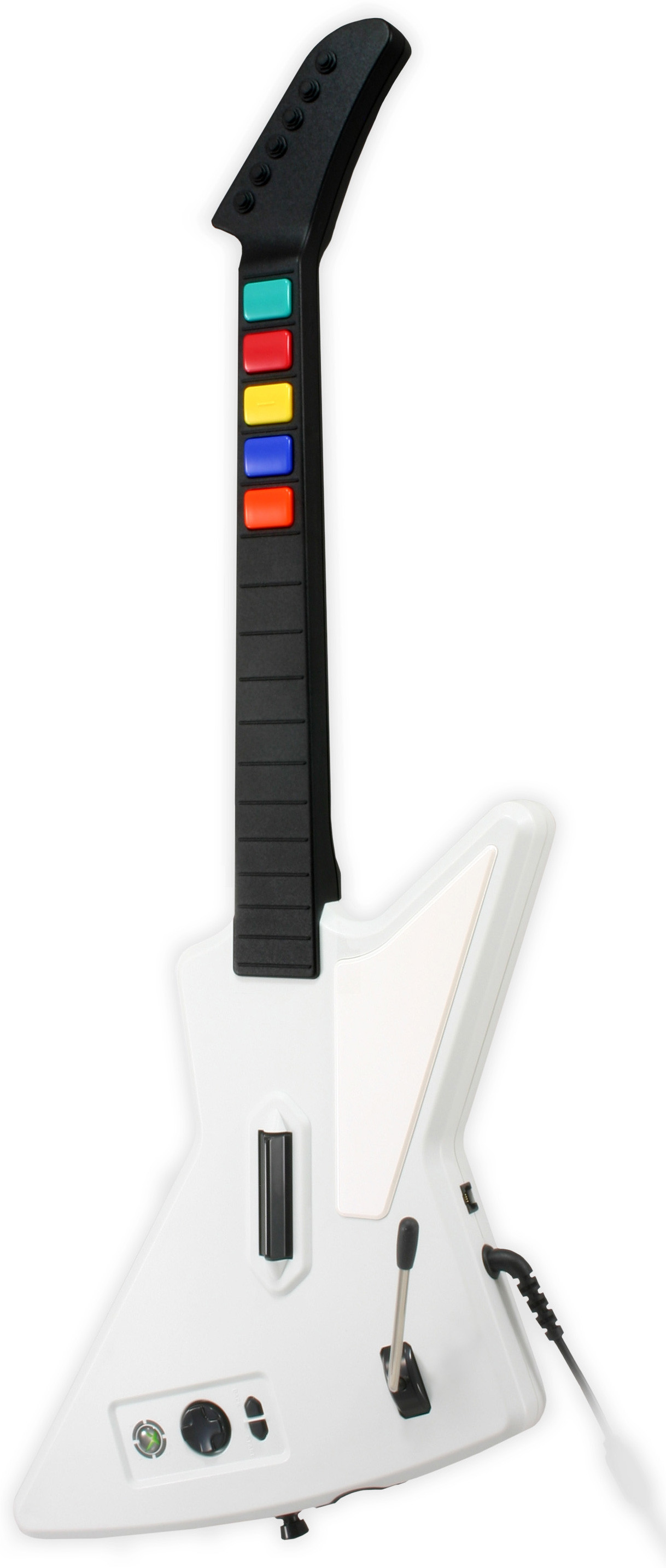 Guitar Hero II Controller RestingLegacy Guitar Hero controller, now potentially compatible with Rock Band 4.
Guitar Hero II Controller RestingLegacy Guitar Hero controller, now potentially compatible with Rock Band 4.
Rock Band 4 embraced backwards compatibility as a core feature, particularly beneficial for PlayStation 4 users. It was designed to be compatible with a wide array of older Rock Band and Guitar Hero wireless peripherals. For PlayStation 4 owners, this meant that many wireless guitar controllers from the PS3 era could potentially be used with Rock Band 4 on PS4.
However, compatibility isn’t absolute. Due to device authentication protocols, wired controllers are generally not supported. Therefore, while wireless PS3 guitar controllers were largely compatible with Rock Band 4 on PS4, wired controllers from previous generations were not. Despite this limitation, Rock Band 4 offered a considerable advantage for players with existing wireless instrument collections.
Conversely, Guitar Hero Live adopted a completely new guitar controller design. This departure from the traditional five-button layout meant that older guitar controllers, regardless of whether they were wired or wireless, were incompatible with Guitar Hero Live. The redesigned guitar gameplay of Guitar Hero Live necessitated new peripherals, eliminating any backwards compatibility.
Winner – Rock Band 4
Round 2: Guitar Gameplay Experience on PS4
While Rock Band expanded the rhythm game experience to include drums, vocals, and bass, the guitar remains the iconic instrument for many players. For those primarily interested in guitar gameplay on their PS4, the mechanics and feel of each game’s guitar implementation are paramount.
Rock Band 4 retained the classic five-color lane highway system that defined previous Guitar Hero and Rock Band titles. PlayStation 4 players familiar with earlier rhythm games would find the guitar gameplay in Rock Band 4 immediately accessible and comfortable. The core mechanics remained largely unchanged, ensuring a smooth transition for returning players on PS4. A notable addition was freestyle guitar solo sections, intended to inject more improvisation into the gameplay.
 Rock Band 4 Gameplay on PS4Rock Band 4’s familiar note highway on PlayStation 4.
Rock Band 4 Gameplay on PS4Rock Band 4’s familiar note highway on PlayStation 4.
These freestyle solos allowed players to strum and fret notes freely, with the game attempting to harmonize the input into a coherent solo. While a novel concept, the execution sometimes fell short, producing less-than-ideal musical results. However, the freestyle solos were optional and did not detract from the core guitar playing experience on PS4.
In contrast, Guitar Hero Live completely overhauled the guitar gameplay. It introduced a new guitar controller with two rows of three buttons, abandoning the five-color system entirely. This innovative approach aimed to simulate the feel of playing a real guitar more closely. On higher difficulty settings, players would navigate complex chord shapes spanning both button rows, offering a more challenging and arguably more rewarding guitar playing experience on PS4 once mastered.
This radical redesign was a bold move, spearheaded by Freestyle Games, renowned for their work on DJ Hero. The new Guitar Hero Live guitar system, after an initial adjustment period, offered a fresh and arguably improved take on rhythm guitar gameplay compared to the established five-color standard. For players seeking a differentiated guitar experience on PS4, Guitar Hero Live presented a compelling alternative.
Winner – Guitar Hero Live
Round 3: Instrument Variety and Band Experience
The scope of instrument options significantly differentiates Rock Band 4 and Guitar Hero Live. For players interested in a full band experience on PS4, the availability of multiple instrument types is a crucial factor.
Rock Band 4 continued its tradition of offering a comprehensive band gameplay experience. It included support for drums, bass guitar, and vocals, in addition to lead guitar. PlayStation 4 gamers could assemble a virtual band locally, each player taking on a different instrument. Rock Band 4 on PS4 largely maintained compatibility with previous wireless instrument controllers for these roles as well, further enhancing its appeal for group play.
However, Rock Band 4 notably dropped support for keyboards, an instrument that had been introduced in Rock Band 3. This omission was a setback for players who enjoyed the keyboard gameplay aspect of the franchise. Despite this, Rock Band 4 remained the definitive choice for players seeking a full band rhythm game on PS4.
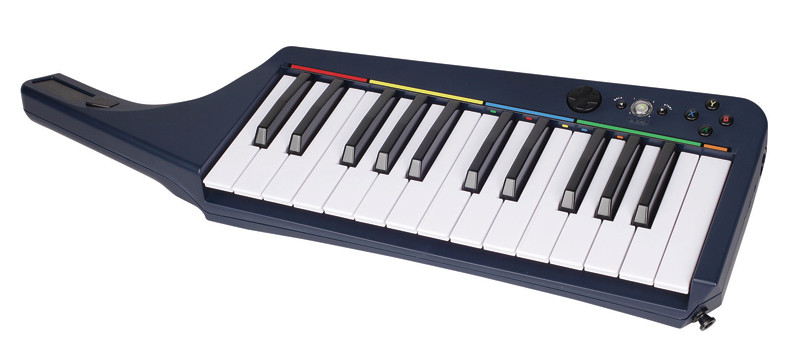 Rock Band 3 Keyboard – Not Supported in Rock Band 4The Rock Band 3 keyboard, lacking support in Rock Band 4.
Rock Band 3 Keyboard – Not Supported in Rock Band 4The Rock Band 3 keyboard, lacking support in Rock Band 4.
Guitar Hero Live, in a deliberate design choice, focused exclusively on the lead guitar experience. It eliminated drums and bass guitar entirely, streamlining the gameplay to center solely on guitar performance. While Guitar Hero Live offered a vocal mode via microphone or a companion mobile app, it was primarily conceived as a lead guitar-centric game. For PlayStation 4 players seeking a band-oriented experience, Guitar Hero Live lacked the instrument variety of Rock Band 4.
Winner – Rock Band 4
Round 4: Visual Design and Presentation on PS4
Visual aesthetics and presentation are subjective aspects, but they contribute significantly to the overall gaming experience. The visual styles of Rock Band 4 and Guitar Hero Live differed dramatically, impacting the atmosphere and immersion for PlayStation 4 players.
Rock Band 4 maintained a visual style consistent with previous entries in the series. While offering expected graphical enhancements for the PS4 generation, the core aesthetic remained familiar. Players still created stylized polygonal characters and bands, a visual hallmark of the Rock Band franchise.
 Rock Band 4 Visual Style on PS4The familiar character style of Rock Band 4 on PlayStation 4.
Rock Band 4 Visual Style on PS4The familiar character style of Rock Band 4 on PlayStation 4.
This visual continuity ensured seamless integration of downloadable content (DLC) songs, a key feature of Rock Band. The established engine efficiently handled a vast library of songs, maintaining visual consistency across both on-disc and DLC tracks on PS4.
Guitar Hero Live adopted a radical visual departure, emphasizing full-motion video over rendered graphics. This approach manifested in two primary modes: Guitar Hero TV (GHTV) and GH Live. GHTV presented a streaming music television channel concept, where players performed along to official music videos. This mode offered a dynamic and visually engaging way to discover new music within the game.
The GH Live mode immersed players in first-person live concert performances. Crowd reactions dynamically shifted based on player performance, creating a sense of direct interaction with the virtual audience and bandmates. However, the execution of this mode received mixed reception.
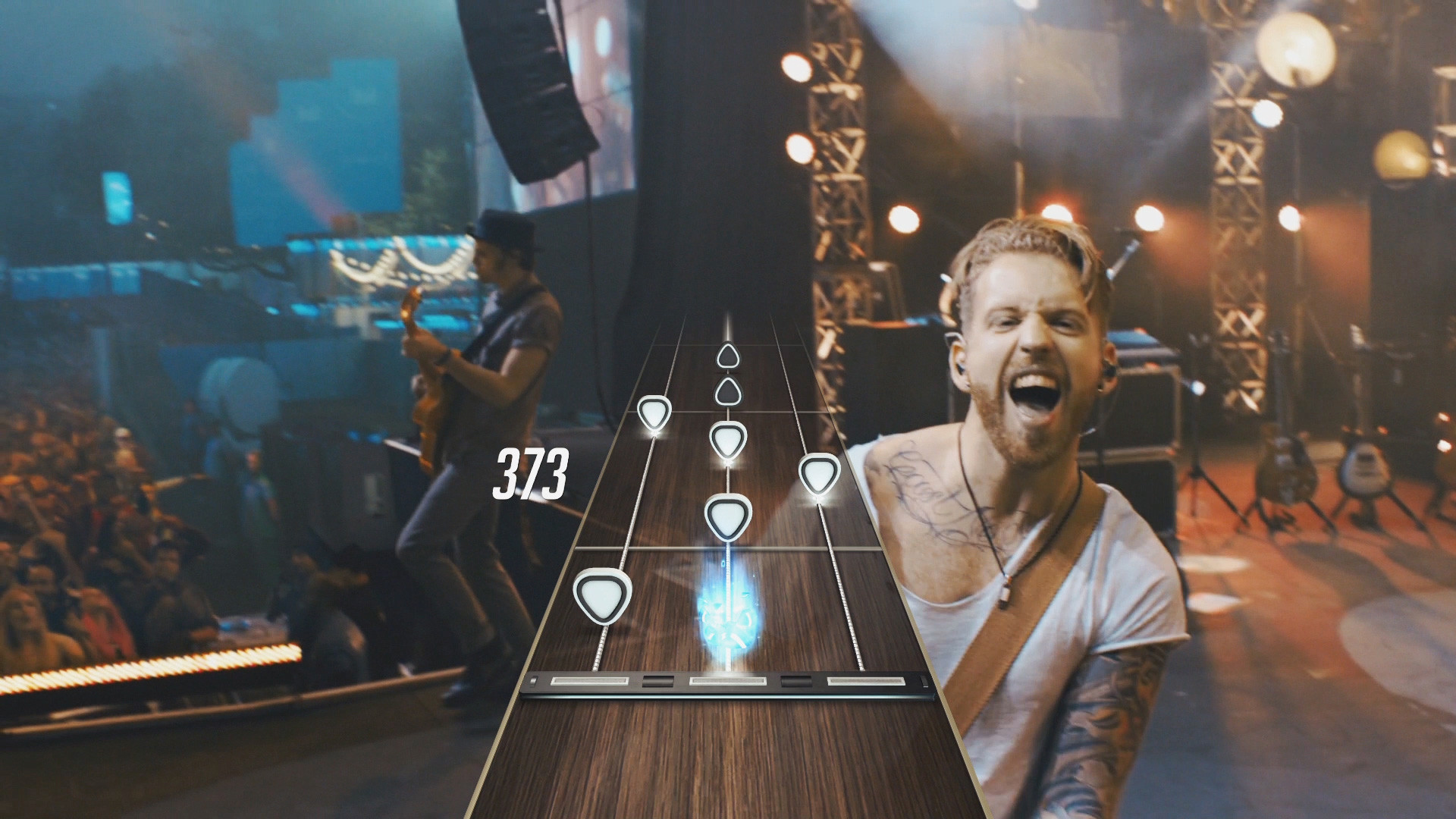 Guitar Hero Live First Person PerspectiveThe first-person perspective in Guitar Hero Live’s GH Live mode on PS4.
Guitar Hero Live First Person PerspectiveThe first-person perspective in Guitar Hero Live’s GH Live mode on PS4.
While technically impressive, some found the acting and scenarios in GH Live to be unconvincing and even off-putting. The hyper-realistic and idealized depiction of band members and audiences struck some players as unrealistic and detracting from the immersion. Despite this divisive GH Live mode, the GHTV mode’s music video integration provided a visually distinct and arguably superior presentation compared to Rock Band 4 for many players.
Winner – Guitar Hero Live
Round 5: On-Disc and Free Content Availability
The initial content offering and opportunities for free content are crucial factors, particularly for players hesitant to invest heavily in downloadable content. The approaches to on-disc and free content differed significantly between Rock Band 4 and Guitar Hero Live on PS4.
Rock Band 4 launched with 65 on-disc songs, spanning a wide range of genres and eras. This provided a substantial initial library for PlayStation 4 players right out of the box. While Rock Band 4 offered occasional free songs through its online catalog, the primary means of expanding the song library was through paid downloadable content. Even importing songs from previous Rock Band titles often required an additional fee.
Guitar Hero Live featured a smaller selection of 42 on-disc songs in its GH Live mode. However, the GHTV mode launched with a library of approximately 200 playable music videos, accessible at no additional cost. This streaming library was continuously updated with new songs post-launch, providing a steady influx of free content for PlayStation 4 players.
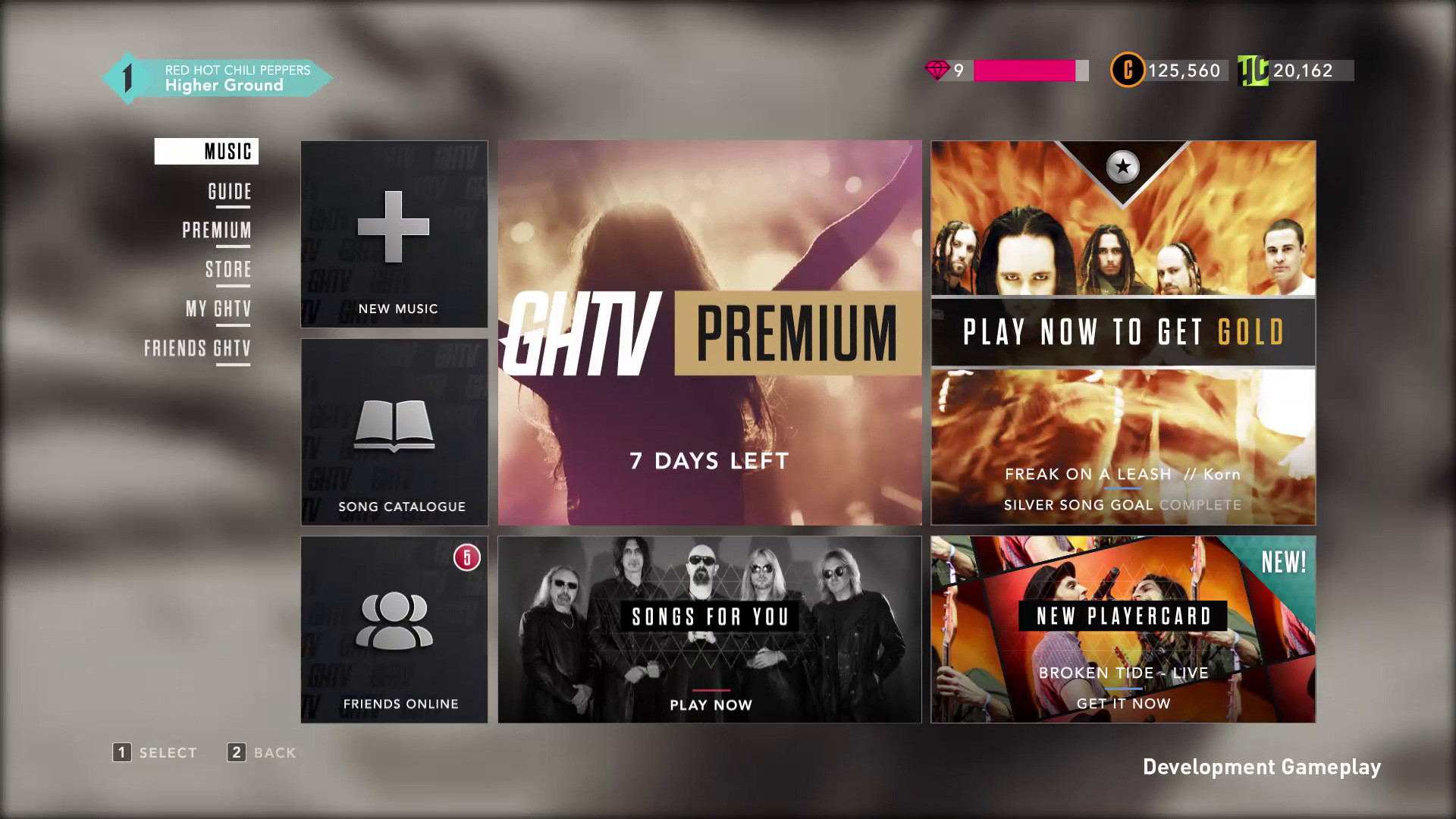 Guitar Hero Live GHTV Mode on PS4Guitar Hero Live’s GHTV mode offering a large library of songs on PS4.
Guitar Hero Live GHTV Mode on PS4Guitar Hero Live’s GHTV mode offering a large library of songs on PS4.
While GHTV’s streaming nature meant players didn’t have immediate on-demand access to every song, in-game currency earned through gameplay could be used to purchase “play tokens.” These tokens allowed players to select and play specific songs on demand within the GHTV library. For players prioritizing a large initial content library and ongoing free content updates on PS4, Guitar Hero Live offered a more compelling proposition than Rock Band 4.
Winner – Guitar Hero Live
Round 6: Downloadable Content and Song Library Expansion
For players willing to invest in downloadable content to expand their song libraries, the DLC ecosystems of Rock Band 4 and Guitar Hero Live presented contrasting models on PS4.
Guitar Hero Live, despite its extensive GHTV library, offered a less traditional DLC experience. While GHTV provided a large song selection, players never truly “owned” these songs in the conventional sense. On-demand access required play tokens, creating a recurring need to either earn in-game currency or purchase tokens with real money. Furthermore, the GH Live mode, with its bespoke full-motion video performances, did not receive any post-launch DLC song additions. The 42 on-disc songs remained the only playable tracks in GH Live mode.
Rock Band 4, in contrast, boasted a robust and conventional DLC ecosystem. A vast majority of the downloadable content released for Rock Band 3 was ported to Rock Band 4, creating a massive library of over 1500 songs available for purchase on PS4. Purchased DLC songs in Rock Band 4 were permanently owned and playable at any time, offering a traditional model of song library expansion.
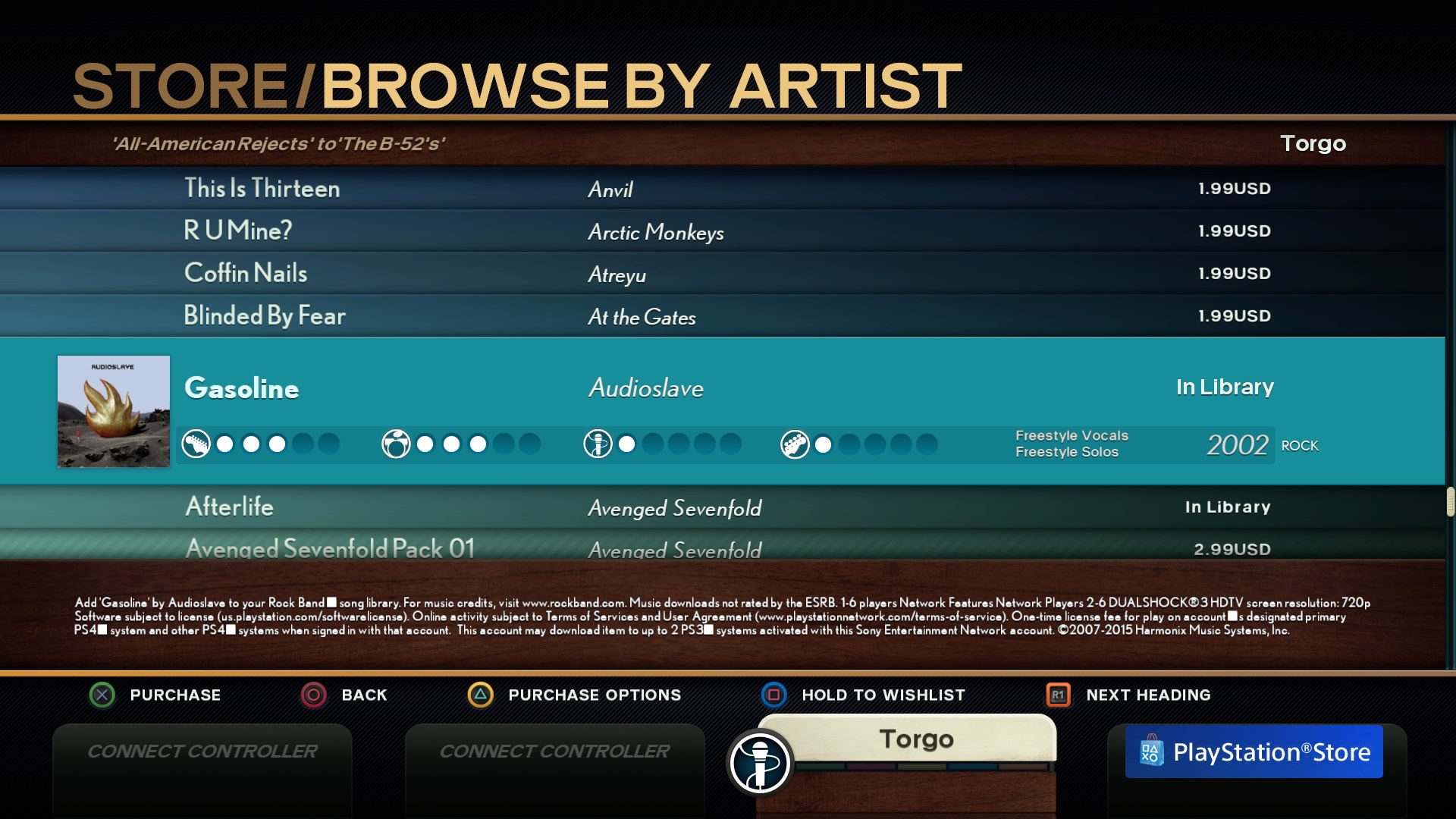 Rock Band 4 DLC Store on PS4The extensive DLC library available for Rock Band 4 on PlayStation 4.
Rock Band 4 DLC Store on PS4The extensive DLC library available for Rock Band 4 on PlayStation 4.
For PlayStation 4 players intending to build a substantial and permanently owned song library through downloadable content, Rock Band 4 provided a significantly more appealing and expansive option compared to Guitar Hero Live.
Winner – Rock Band 4
Round 7: Single-Player Gameplay Depth
The single-player experiences in rhythm games cater to different player preferences. For solo gamers on PS4, the depth and progression systems in Rock Band 4 and Guitar Hero Live offered contrasting gameplay loops.
Guitar Hero Live, with its focus on lead guitar and first-person perspective, was designed with single-player engagement in mind. The GHTV mode incorporated a profile progression system where players earned experience points, leveled up, and unlocked customization items like note highways and profile icons. GHTV songs also featured specific challenges, adding replayability and encouraging players to improve their scores.
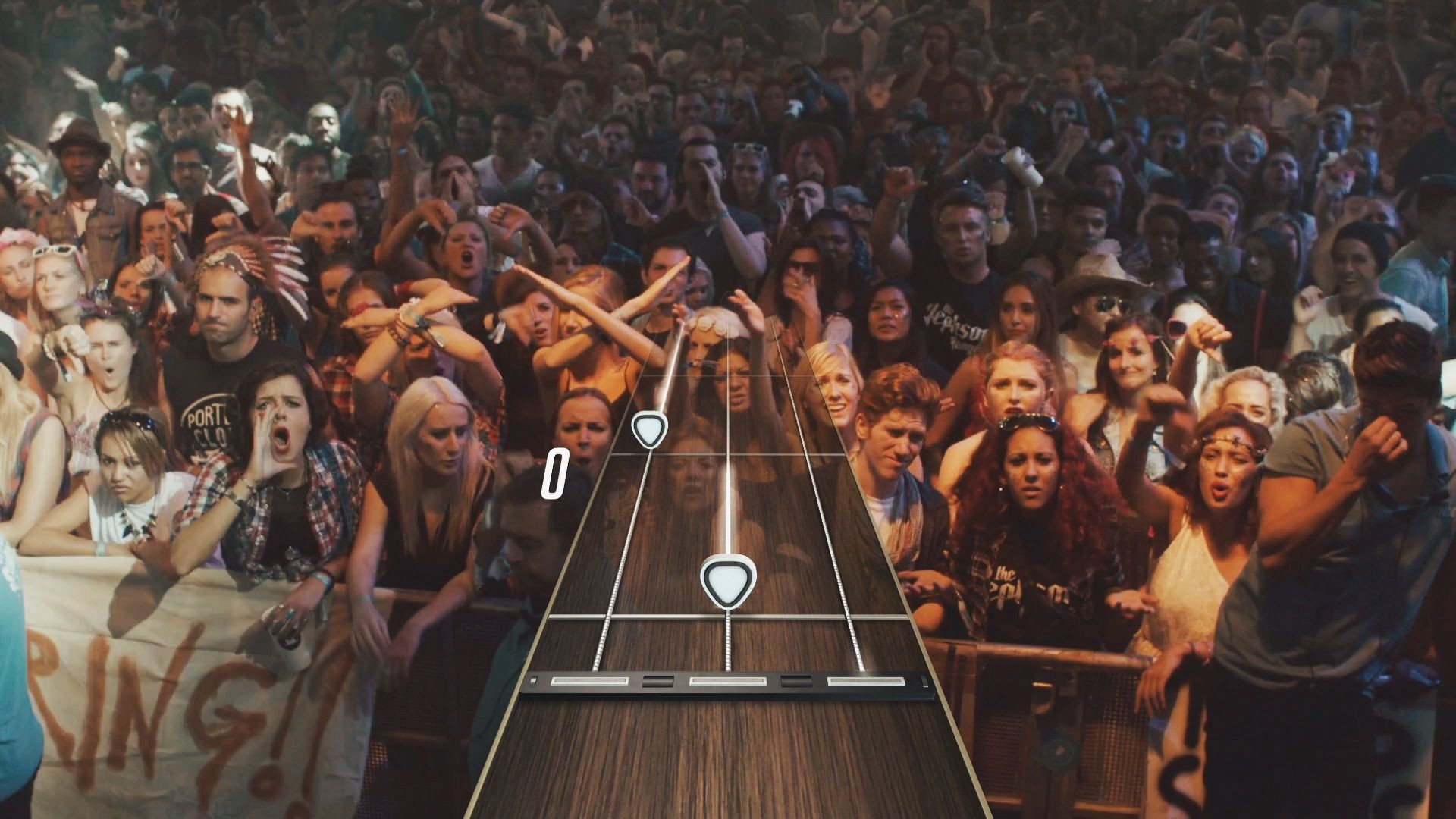 Guitar Hero Live Single Player ExperienceGuitar Hero Live’s GHTV mode tailored for single-player progression on PS4.
Guitar Hero Live Single Player ExperienceGuitar Hero Live’s GHTV mode tailored for single-player progression on PS4.
Rock Band 4 offered a Career mode, but it was considered relatively short compared to previous installments. Beyond Career mode, single-player options largely consisted of Quick Play mode, where players could select individual songs. Rock Band 4 placed less emphasis on structured single-player progression systems compared to Guitar Hero Live. For PlayStation 4 gamers seeking a more defined sense of single-player progression and reward, Guitar Hero Live offered a more compelling experience.
Winner – Guitar Hero Live
Round 8: Local Multiplayer and Social Gaming
Local multiplayer is a cornerstone of the plastic instrument genre, and the implementation of multiplayer modes significantly impacts the social gaming experience on PS4.
Guitar Hero Live‘s local multiplayer capabilities were notably limited. It only supported a second guitar player in the GHTV mode, and both players performed the same guitar part. This resulted in a competitive, score-based multiplayer experience rather than a cooperative band dynamic. Given the social nature of rhythm games, this limited multiplayer implementation was a significant drawback for players interested in local cooperative play on PS4.
 Guitar Hero Live Limited MultiplayerGuitar Hero Live’s restrictive local multiplayer mode on PS4.
Guitar Hero Live Limited MultiplayerGuitar Hero Live’s restrictive local multiplayer mode on PS4.
Rock Band 4, in contrast, remained a multiplayer-focused title. It supported full band local multiplayer, allowing up to four players to perform together on guitar, bass, drums, and vocals. While Rock Band 4 didn’t revolutionize the local multiplayer formula, it retained the well-regarded cooperative band gameplay that defined the series. For PlayStation 4 gamers prioritizing local multiplayer and social band experiences, Rock Band 4 was the clear superior choice.
Winner – Rock Band 4
Round 9: Ongoing Updates and Post-Launch Support
Long-term support and content updates are crucial for rhythm games intended as ongoing platforms rather than standalone releases. Both Rock Band 4 and Guitar Hero Live demonstrated commitment to post-launch updates, albeit with different approaches.
Rock Band 4 received updates introducing new features, social score challenges, character customization options, and gameplay modes like Brutal Mode, which dynamically increased difficulty based on player performance. These updates enhanced the core Rock Band 4 experience and added new layers of engagement for PlayStation 4 players.
Guitar Hero Live continued to expand its GHTV library with a steady stream of new songs, adding over 90 tracks within a couple of months post-launch. Updates also introduced customization options and online multiplayer features, such as a Rivals mode that matched players against similarly skilled opponents in GHTV.
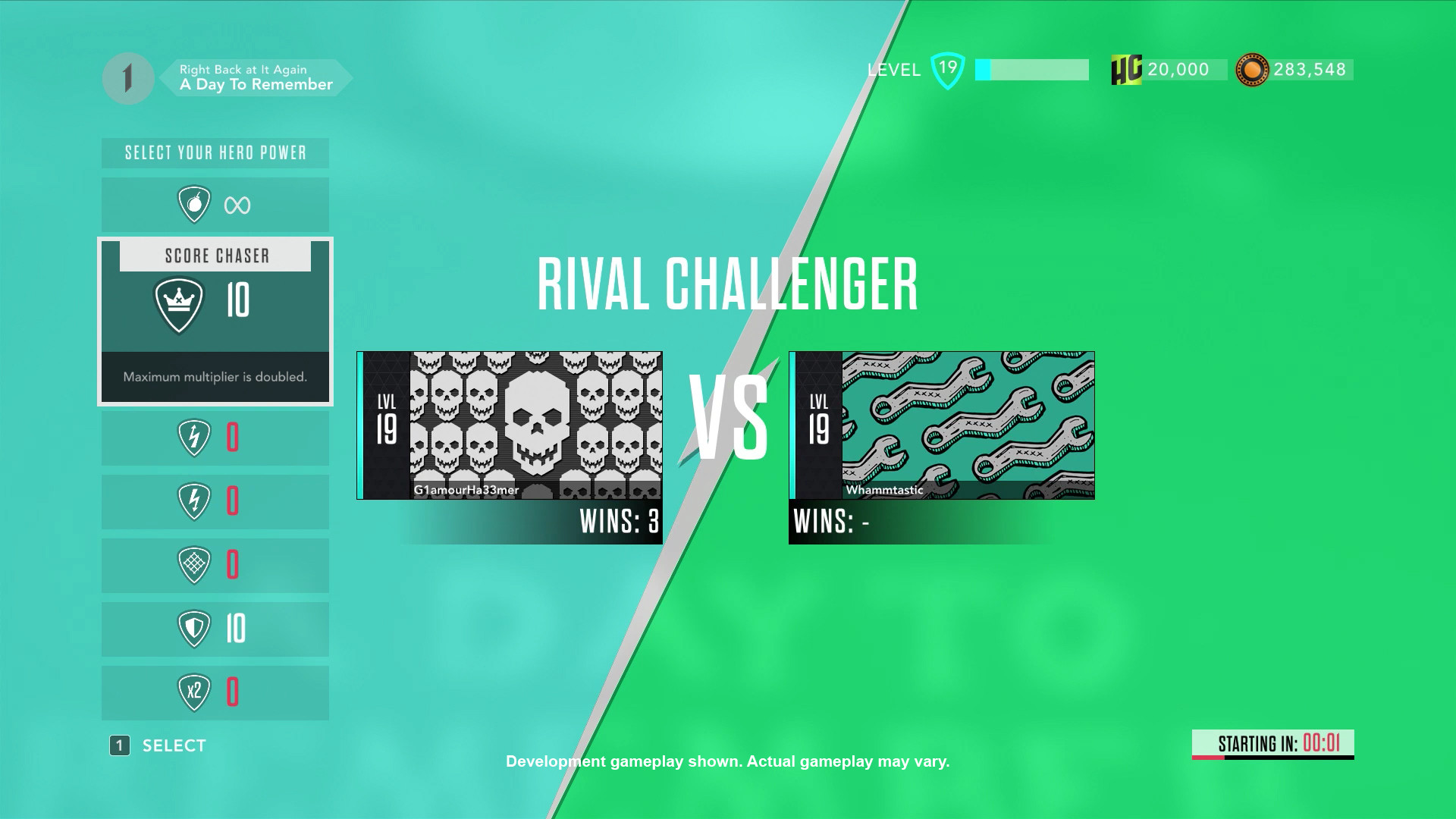 Guitar Hero Live Rivals ModeGuitar Hero Live’s Rivals mode, adding online competitive elements on PS4.
Guitar Hero Live Rivals ModeGuitar Hero Live’s Rivals mode, adding online competitive elements on PS4.
Both games demonstrated a commitment to ongoing support and updates, enriching the player experience on PS4 beyond the initial launch content.
Winner – Draw
The Verdict: Choosing Between Rock Band 4 and Guitar Hero Live for Guitar on PS4
Ultimately, the choice between Rock Band 4 and Guitar Hero Live for PlayStation 4 depends on individual player preferences and priorities, particularly regarding guitar gameplay and social experience.
If single-player guitar gameplay and a focus on personal progression are paramount, Guitar Hero Live emerges as a strong contender. Its redesigned guitar controller offers a fresh and challenging experience, and the GHTV mode provides a dynamic and constantly evolving library of playable songs. Despite the divisive GH Live mode, the innovative guitar gameplay and GHTV content make Guitar Hero Live a compelling option for solo guitarists on PS4.
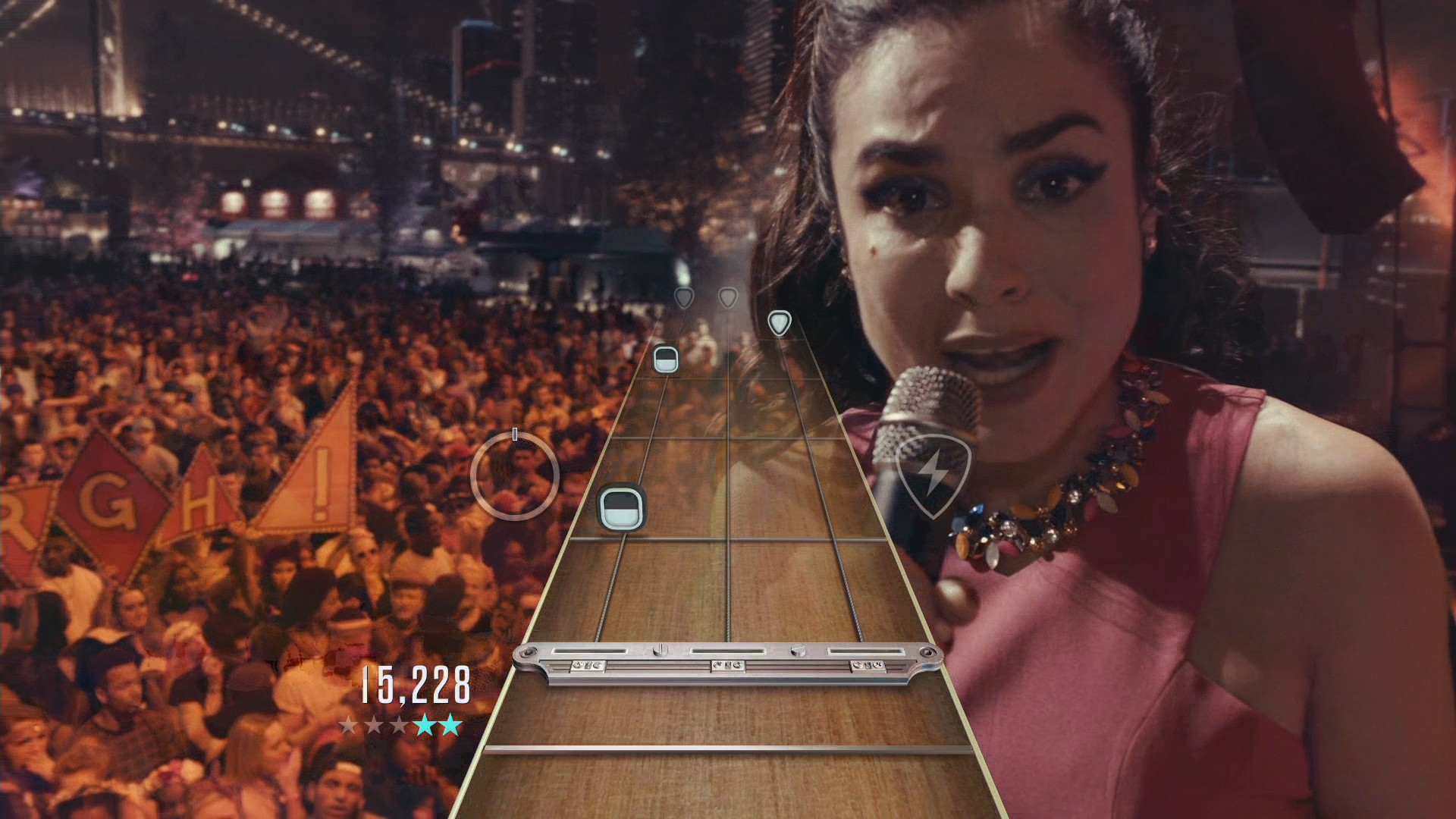 Guitar Hero Live Guitar ControllerThe redesigned Guitar Hero Live guitar controller.
Guitar Hero Live Guitar ControllerThe redesigned Guitar Hero Live guitar controller.
Conversely, if local multiplayer, a full band experience, and a vast, expandable song library are primary considerations, Rock Band 4 is the definitive choice for PlayStation 4. Its backwards compatibility with legacy instruments, robust multiplayer modes, and extensive DLC catalog cater to players seeking social rhythm game experiences and long-term song collection.
 Rock Band 4 Multiplayer on PS4Rock Band 4 excels in local multiplayer band gameplay on PlayStation 4.
Rock Band 4 Multiplayer on PS4Rock Band 4 excels in local multiplayer band gameplay on PlayStation 4.
Considering pricing, at launch Guitar Hero Live with a guitar controller was generally more affordable than Rock Band 4 with a guitar bundle. However, Rock Band 4 offered a lower entry point for players with existing compatible instruments.
In conclusion, for PlayStation 4 owners specifically interested in guitar rhythm games, both Rock Band 4 and Guitar Hero Live offer distinct strengths. Guitar Hero Live innovates with guitar gameplay and content delivery, while Rock Band 4 excels in social band experiences and song library depth. The ideal choice hinges on whether your priority is pioneering solo guitar action or classic band-focused multiplayer fun on PS4.
